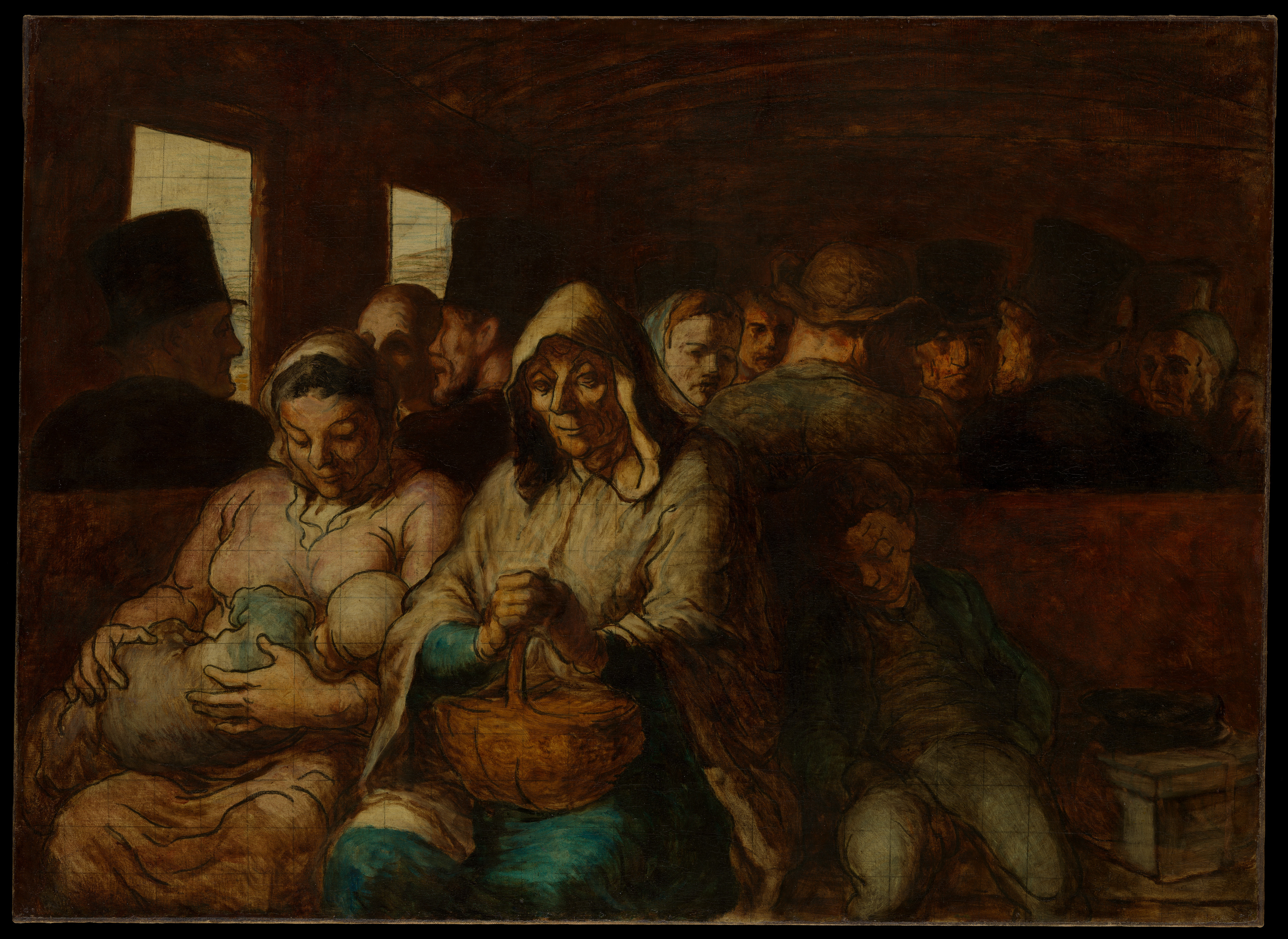You must join the virtual exhibition queue when you arrive. If capacity has been reached for the day, the queue will close early.
Learn more
Jump to content tickets Member | Make a donation
- The Collection
- The American Wing Ancient Near Eastern Art Arms and Armor The Michael C. Rockefeller Wing Asian Art The Cloisters The Costume Institute Drawings and Prints Egyptian Art European Paintings European Sculpture and Decorative Arts Greek and Roman Art Islamic Art Robert Lehman Collection The Libraries Medieval Art Musical Instruments Photographs Antonio Ratti Textile Center Modern and Contemporary Art
Crop your artwork:
Scan your QR code:
Gratefully built with ACNLPatternTool
Honoré Daumier French
On view at The Met Fifth Avenue in Gallery 802
As a graphic artist and painter, Daumier chronicled the impact of industrialization on modern urban life in mid-nineteenth-century Paris. Here, he amplifies the subject of a lithograph made some ten years earlier: the hardship and quiet fortitude of third-class railway travelers. Bathed in light, the nursing mother, elderly woman, and sleeping boy emanate a serenity not often associated with public transport. Unfinished and squared for transfer, this picture closely corresponds to a watercolor of 1864 (Walters Art Museum, Baltimore) and a finished oil painting (National Gallery of Canada, Ottawa).
0:00
0:00
View Transcript
Open Access
As part of the Met's Open Access policy, you can freely copy, modify and distribute this image, even for commercial purposes.
API
Public domain data for this object can also be accessed using the Met's Open Access API.
- Download image



This artwork is meant to be viewed from right to left. Scroll left to view more.
Due to rights restrictions, this image cannot be enlarged, viewed at full screen, or downloaded.
Fig. 1. Honoré Daumier, "The Third-Class Carriage," ca. 1863–65, oil on canvas, 25 3/4 x 35 1/2 in. (65.4 x 90.2 cm). National Gallery of Canada, Ottawa, Purchased 1946, no. 4633. Photo © National Gallery of Canada
Due to rights restrictions, this image cannot be enlarged, viewed at full screen, or downloaded.
Fig. 2. Honoré Daumier, "The Third-Class Carriage," 1864, watercolor, ink wash, and charcoal on slightly textured, moderately thick, cream laid paper, 8 x 11 5/8 in. (20.3 x 29.5 cm). Walters Art Museum, Baltimore, 37.122
Artwork Details
Use your arrow keys to navigate the tabs below, and your tab key to choose an item
Title: The Third-Class Carriage
Artist: Honoré Daumier (French, Marseilles 1808–1879 Valmondois)
Date: 1864
Medium: Oil on canvas
Dimensions: 25 3/4 x 35 1/2 in. (65.4 x 90.2 cm)
Classification: Paintings
Credit Line: H. O. Havemeyer Collection, Bequest of Mrs. H. O. Havemeyer, 1929
Accession Number: 29.100.129
Learn more about this artwork
The Artist Project: Swoon
Artist Swoon reflects on Honoré Daumier's The Third-Class Carriage in this episode of The Artist Project.
Connections: Privilege
Art preparator Theresa King-Dickinson ruminates on the universal privilege of art appreciation.
Timeline of Art History
Essay
Nineteenth-Century French Realism
Chronology
France, 1800-1900 A.D.
Museum Publications
Walker Evans
Unfinished: Thoughts Left Visible
The Metropolitan Museum of Art: Masterpiece Paintings
The Metropolitan Museum of Art. Vol. 7, Europe in the Age of Enlightenment and Revolution
The Metropolitan Museum of Art Guide (Spanish)
The Metropolitan Museum of Art Guide (Russian)
The Metropolitan Museum of Art Guide (Portuguese)
The Metropolitan Museum of Art Guide (Korean)
The Metropolitan Museum of Art Guide (Japanese)
The Metropolitan Museum of Art Guide (Italian)
The Metropolitan Museum of Art Guide (German)
The Metropolitan Museum of Art Guide (French)
The Metropolitan Museum of Art Guide (Chinese)
The Metropolitan Museum of Art Guide (Arabic)
The Metropolitan Museum of Art Guide
The Metropolitan Museum of Art Guide
The Metropolitan Museum of Art Guide
The Artist Project: What Artists See When They Look At Art
The Artist Project
Splendid Legacy: The Havemeyer Collection
One Met. Many Worlds.
Masterpieces of The Metropolitan Museum of Art
Masterpieces of The Metropolitan Museum of Art
Masterpieces of European Painting, 1800–1920, in The Metropolitan Museum of Art
French Paintings: A Catalogue of the Collection of The Metropolitan Museum of Art. Vol. 2, Nineteenth Century
European Paintings in The Metropolitan Museum of Art by Artists Born before 1865: A Summary Catalogue
Daumier Drawings
Art = Discovering Infinite Connections in Art History
A Concise Catalogue of the European Paintings in the Metropolitan Museum of Art
"The Wet Nurse in Daumier's*Third-Class Carriage*"
Related Artworks
- All Related Artworks
- In the same gallery
- By Honoré Daumier
- European Paintings
- Canvas
- Oil paint
- Paintings
- From Europe
- From France
- From A.D. 1800–1900
The New Oedipus before the New Sphinx (Le nouvel Œdipe devant le nouveau Sphinx), from Actualités
Honoré Daumier (French, Marseilles 1808–1879 Valmondois)
1851
Standing Figure of a Man with a Staff
Honoré Daumier (French, Marseilles 1808–1879 Valmondois)
1825–79
Album Chaos Caricature de tout le monde
Honoré Daumier (French, Marseilles 1808–1879 Valmondois)
[1840]
La Mort de Sapho, from Histoire Ancienne, published in Le Charivari, January 4, 1843
Honoré Daumier (French, Marseilles 1808–1879 Valmondois)
January 4, 1843
Rifolard ouvre le bal. . .
Honoré Daumier (French, Marseilles 1808–1879 Valmondois)
November 21, 1848
Resources for Research
The Met's Libraries and Research Centers provide unparalleled resources for research and welcome an international community of students and scholars.
The Met Collection API is where all makers, creators, researchers, and dreamers can connect to the most up-to-date data and public domain images for The Met collection. Open Access data and public domain images are available for unrestricted commercial and noncommercial use without permission or fee.
Feedback
We continue to research and examine historical and cultural context for objects in The Met collection. If you have comments or questions about this object record, please complete and submit this form. The Museum looks forward to receiving your comments.
European Paintings at The Met
The Met's celebrated European Paintings collection encompasses more than 2,500 works of art from the thirteenth through the early twentieth century.


